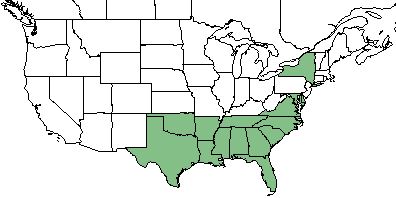Symplocos tinctoria
Common names: common sweetleaf [1],horsesugar [2]
| Symplocos tinctoria | |
|---|---|

| |
| Photo by John Gwaltney hosted at Southeastern Flora.com | |
| Scientific classification | |
| Kingdom: | Plantae |
| Division: | Magnoliophyta - Flowering plants |
| Class: | Magnoliopsida - Dicots |
| Order: | Ebenales |
| Family: | Symplocaceae |
| Genus: | Symplocos |
| Species: | S. tinctoria |
| Binomial name | |
| Symplocos tinctoria (L.) L'Her. | |

| |
| Natural range of Symplocos tinctoria from USDA NRCS Plants Database. | |
Contents
Taxonomic Notes
Synonym: S. tinctoria var. pygmaea (Fernald), S. tinctoria var. ashei (Harbison)
Variety: none
Description
S. tinctoria is a perennial shrub/tree of the Symplocaceae family that is native to North America. [1]
Distribution
S. tinctoria is found in Florida, Georgia, South Carolina, North Carolina, Virginia, Maryland, Delaware, New York, Tennessee, Alabama, Mississippi, Louisiana, Arkansas, Oklahoma, and Texas. [1]
Ecology
Habitat
Habitats for S. tinctoria include moist bottomland forest, pocosin edges, mesic forests, ridgetop forests, and sandhills. [3] Specimens have been collected from moist soil of mixed hardwoods, dry woods, ravine above stream, slope near floodplains, open upland woodland, upland hammock, and mesic hammock. [4]
Soils that are medum to coarse in texture are hospitable for S. tinctoria. [1]
This species is not tolerance of drought but is tolerant of shade. [1]
Phenology
S. tinctoria has been observed flowering January through June with peak inflorescence in March. [5] It has been found that this species increased in production after a prescribed burn. [6]
Use by animals
This species is a common food source for the white tailed deer. [2]
Diseases and parasites
Galls due to a fungus has been observed on a plant in northeast Pensacola, Fl. .[7]
Conservation and Management
Cultivation and restoration
Photo Gallery
References and notes
- ↑ 1.0 1.1 1.2 1.3 1.4 USDA Plant Database
- ↑ 2.0 2.1 Atwood, E. L. (1941). "White-tailed deer foods of the United States." The Journal of Wildlife Management 5(3): 314-332.
- ↑ Weakley, A. S. (2015). Flora of the Southern and Mid-Atlantic States. Chapel Hill, NC, University of North Carolina Herbarium.
- ↑ URL: http://herbarium.bio.fsu.edu. Last accessed: June 2018. Collectors: Loran C. Anderson, R.K. Godfrey, A.H. Curtiss, Richland S. Mitchell, Sidney McDaniel, Paul Redfearn, Gwynn Ramsey, K. Craddock Burks, Rodie White, R.A. Norris, R. Komarek, J.M. Kane, John B. Nelson, Bert Pittman, Kathy Boyle, Herrick Brown, Richard Carter, Ron Miller. States and counties: Florida (Escambia, Okaloosa, Duval, Calhoun, Liberty, Jackson, Holmes, Gadsden, Leon, Jefferson, Columbia, Suwannee, Santa Rosa, Washington, Wakulla) Georgia (Grady, Thomas, McIntosh) South Carolina (Richland, Berkeley)
- ↑ Nelson, G. PanFlora: Plant data for the eastern United States with emphasis on the Southeastern Coastal Plains, Florida, and the Florida Panhandle. www.gilnelson.com/PanFlora/ Accessed: 29 MAY 2018
- ↑ Lay, D. W. (1967). "Browse palatability and the effects of prescribed burning in southern pine forests." Journal of Forestry 65: 826-828.
- ↑ Observation by Steve Gallagher in Pensacola, Fl. March 12, 2018, posted to Florida Flora and Ecosystematics Facebook Group March 12, 2018.